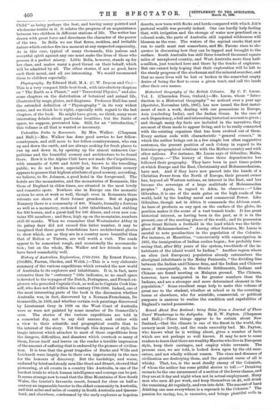Historical Geography of the British Colonies. By C. P. Lucas.
Vol. I. (Clarendon Press, Oxford.)—Mr. Lucas, whose " Intro- duction to a Historical Geography" we noticed over a year ago (Spectator, November 12th, 1887), has now issued the first instal- ment of such a work, dealing with our possessions in Europe, Asia (excluding India), and the Indian Ocean. In the case of each Dependency, a full and interesting historical account is given ; and though many dry facts are included in the narrative, they are most of them made to appear living, and to be really connected with the existing organism that has been evolved out of them. Every section ends with characteristic " general résumés," in which the author brings out in a few simple but often suggestive sentences, the present position of each Colony in regard to its historico-geographical relations with the Mother-country and with other nations. For instance, Mr. Lucas says of Gibraltar, Malta, and Cyprus :—" The history of these three dependencies has followed their geography. They have been in past times points at which Europe and the East, Christianity and Mohammedanism, have met. And if they have now passed into the hands of a Christian Power from the North of Europe, their present owner has, beyond all Western nations, an interest in the East, and has become the sovereign of a large multitude of Mohammedan peoples." Again, in regard to Aden, he observes :—" Like Gibraltar, it is one of the main gates on the high roads of the world, held by the leading naval and commercial Power. Like Gibraltar, though not in Africa it commands the African coast. As bare of products as any spot on the surface of the globe, its position makes it the scene of a vast transit trade. It has great historical interest, as having been in the past, as it is in the present, one of the meeting places of the world ; and its possession gives Great Britain a foothold in the land which was the birth- place of Mohammedanism." Among other features, Mr. Lucas is careful to note peculiarities in the population of the Colonies. For instance, at Mauritius, "concurrently with emancipation in 1835, the immigration of Indian coolies began ; few probably fore- seeing that, after fifty years of the system, two-thirds of the in- habitants of the island would be Indian." Another region where an alien (not European) population already outnumbers the aboriginal inhabitants is the Malay Peninsula, "the dividing line between the Indian and Chinese Seas, and the Indian and Chinese races ; consequently, in the Straits Settlements, Indians and Chinese are found meeting on Malayan ground. The Chinese, however, have immigrated in far greater numbers than the Indians, and are a stronger and more determined element in the population." Some excellent maps help to make this volume of great use to the student, whether at school or in the counting- house or elsewhere, who for scientific, commercial, or political purposes is anxious to realise the condition and capabilities of England's varied possessions.


















































 Previous page
Previous page